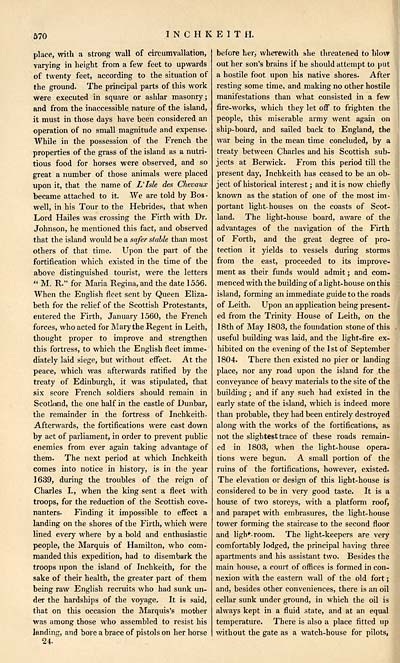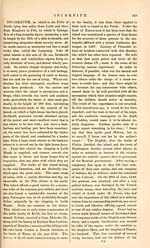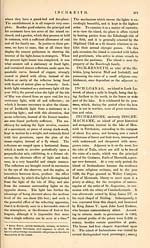Gazetteer of Scotland > Volume 2
(86) Page 570 - INC
Download files
Complete book:
Individual page:
Thumbnail gallery: Grid view | List view

570
INCHKEITH.
place, with a strong wall of circumvallation,
varying in height from a few feet to upwards
of twenty feet, according to the situation of
the ground. The principal parts of this work
were executed in square or ashlar masonry;
and from the inaccessible nature of the island,
it must in those days have been considered an
operation of no small magnitude and expense.
While in the possession of the French the
properties of the grass of the island as a nutri-
tious food for horses were observed, and so
great a number of those animals were placed
upon it, that the name of L'lsle des Chevaux
became attached to it. We are told by Bos ■
well, in his Tour to the Hebrides, that when
Lord Hailes was crossing the Firth with Dr.
Johnson, he mentioned this fact, and observed
that the island would be a safer stable than most
others of that time. Upon the part of the
fortification which existed in the time of the
above distinguished tourist, were the letters
" M. R." for Maria Regina, and the date 1556.
When the English fleet sent by Queen Eliza-
beth for the relief of the Scottish Protestants,
entered the Firth, January 1560, the French
forces, who acted for Mary the Regent in Leith,
thought proper to improve and strengthen
this fortress, to which the English fleet imme-
diately laid siege, but without effect. At the
peace, which was afterwards ratified by the
treaty of Edinburgh, it was stipulated, that
six score French soldiers should remain in
Scothttid, the one half in the castle of Dunbar,
the remainder in the fortress of Inchkeith.
Afterwards, the fortifications were cast down
by act of parliament, in order to prevent public
enemies from ever again taking advantage of
them. The next period at which Inchkeith
comes into notice in history, is in the year
1639, during the troubles of the reign of
Charles I., when the king sent a fleet with
troops, for the reduction of the Scottish cove-
nanters. Finding it impossible to effect a
landing on the shores of the Firth, which were
lined every where by a bold and enthusiastic
people, the Marquis of Hamilton, who com-
manded this expedition, had to disembark the
troops upon the island of Inchkeith, for the
sake of their health, the greater part of them
being raw English recruits who had sunk un-
der the hardships of the voyage. It is said,
that on this occasion the Marquis's mother
was among those who assembled to resist his
landing, and bore a brace of pistols on her horse
24.
before her, wherewith she threatened to blow
out her son's brains if he should attempt to put
a hostile foot upon his native shores. After
resting some time, and making no other hostile
manifestations than what consisted in a few
fire-works, which they let off to frighten the
people, this miserable army went again on
ship-board, and sailed back to England, the
war being in the mean time concluded, by a
treaty between Charles and his Scottish sub-
jects at Berwick. From this period till the
present day, Inchkeith has ceased to be an ob-
ject of historical interest ; and it is now chiefly
known as the station of one of the most im-
portant light-houses on the coasts of Scot-
land. The light-house board, aware of the
advantages of the navigation of the Firth
of Forth, and the great degree of pro-
tection it yields to vessels during storms
from the east, proceeded to its improve-
ment as their funds would admit ; and com-
menced with the building of a light-house on this
island, forming an immediate guide to the roads
of Leith. Upon an application being present-
ed from the Trinity House of Leith, on the
18th of May 1803, the foundation stone of this
useful building was laid, and the light-fire ex-
hibited on the evening of the 1 st of September
1804. There then existed no pier or landing
place, nor any road upon the island for the
conveyance of heavy materials to the site of the
building ; and if any such had existed in the
early state of the island, which is indeed more
than probable, they had been entirely destroyed
along with the works of the fortifications, as
not the slightest trace of these roads remain-
ed in 1803, when the light-house opera-
tions were begun. A small portion of the
ruins of the fortifications, however, existed.
The elevation or design of this light-house is
considered to be in very good taste. It is a
house of two storeys, with a platform roof,
and parapet with embrasures, the light-house
tower forming the staircase to the second floor
and ligb*-room. The light-keepers are very
comfortably lodged, the principal having three
apartments and his assistant two. Besides (he
main house, a court of offices is formed in con-
nexion with the eastern wall of the old fort ;
and, besides other conveniences, there is an oil
cellar sunk under ground, in which the oil is
always kept in a fluid state, and at an equal
temperature. There is also a place fitted up
without the gate as a watch-house for pilots,
INCHKEITH.
place, with a strong wall of circumvallation,
varying in height from a few feet to upwards
of twenty feet, according to the situation of
the ground. The principal parts of this work
were executed in square or ashlar masonry;
and from the inaccessible nature of the island,
it must in those days have been considered an
operation of no small magnitude and expense.
While in the possession of the French the
properties of the grass of the island as a nutri-
tious food for horses were observed, and so
great a number of those animals were placed
upon it, that the name of L'lsle des Chevaux
became attached to it. We are told by Bos ■
well, in his Tour to the Hebrides, that when
Lord Hailes was crossing the Firth with Dr.
Johnson, he mentioned this fact, and observed
that the island would be a safer stable than most
others of that time. Upon the part of the
fortification which existed in the time of the
above distinguished tourist, were the letters
" M. R." for Maria Regina, and the date 1556.
When the English fleet sent by Queen Eliza-
beth for the relief of the Scottish Protestants,
entered the Firth, January 1560, the French
forces, who acted for Mary the Regent in Leith,
thought proper to improve and strengthen
this fortress, to which the English fleet imme-
diately laid siege, but without effect. At the
peace, which was afterwards ratified by the
treaty of Edinburgh, it was stipulated, that
six score French soldiers should remain in
Scothttid, the one half in the castle of Dunbar,
the remainder in the fortress of Inchkeith.
Afterwards, the fortifications were cast down
by act of parliament, in order to prevent public
enemies from ever again taking advantage of
them. The next period at which Inchkeith
comes into notice in history, is in the year
1639, during the troubles of the reign of
Charles I., when the king sent a fleet with
troops, for the reduction of the Scottish cove-
nanters. Finding it impossible to effect a
landing on the shores of the Firth, which were
lined every where by a bold and enthusiastic
people, the Marquis of Hamilton, who com-
manded this expedition, had to disembark the
troops upon the island of Inchkeith, for the
sake of their health, the greater part of them
being raw English recruits who had sunk un-
der the hardships of the voyage. It is said,
that on this occasion the Marquis's mother
was among those who assembled to resist his
landing, and bore a brace of pistols on her horse
24.
before her, wherewith she threatened to blow
out her son's brains if he should attempt to put
a hostile foot upon his native shores. After
resting some time, and making no other hostile
manifestations than what consisted in a few
fire-works, which they let off to frighten the
people, this miserable army went again on
ship-board, and sailed back to England, the
war being in the mean time concluded, by a
treaty between Charles and his Scottish sub-
jects at Berwick. From this period till the
present day, Inchkeith has ceased to be an ob-
ject of historical interest ; and it is now chiefly
known as the station of one of the most im-
portant light-houses on the coasts of Scot-
land. The light-house board, aware of the
advantages of the navigation of the Firth
of Forth, and the great degree of pro-
tection it yields to vessels during storms
from the east, proceeded to its improve-
ment as their funds would admit ; and com-
menced with the building of a light-house on this
island, forming an immediate guide to the roads
of Leith. Upon an application being present-
ed from the Trinity House of Leith, on the
18th of May 1803, the foundation stone of this
useful building was laid, and the light-fire ex-
hibited on the evening of the 1 st of September
1804. There then existed no pier or landing
place, nor any road upon the island for the
conveyance of heavy materials to the site of the
building ; and if any such had existed in the
early state of the island, which is indeed more
than probable, they had been entirely destroyed
along with the works of the fortifications, as
not the slightest trace of these roads remain-
ed in 1803, when the light-house opera-
tions were begun. A small portion of the
ruins of the fortifications, however, existed.
The elevation or design of this light-house is
considered to be in very good taste. It is a
house of two storeys, with a platform roof,
and parapet with embrasures, the light-house
tower forming the staircase to the second floor
and ligb*-room. The light-keepers are very
comfortably lodged, the principal having three
apartments and his assistant two. Besides (he
main house, a court of offices is formed in con-
nexion with the eastern wall of the old fort ;
and, besides other conveniences, there is an oil
cellar sunk under ground, in which the oil is
always kept in a fluid state, and at an equal
temperature. There is also a place fitted up
without the gate as a watch-house for pilots,
Set display mode to: Large image | Transcription
Images and transcriptions on this page, including medium image downloads, may be used under the Creative Commons Attribution 4.0 International Licence unless otherwise stated. ![]()
| Gazetteers of Scotland, 1803-1901 > Gazetteer of Scotland > Volume 2 > (86) Page 570 - INC |
|---|
| Permanent URL | https://digital.nls.uk/97431854 |
|---|
| Description | Volume II: Glenbanchor to Zetland. |
|---|---|
| Attribution and copyright: |
|
| Description | By Robert Chambers and William Chambers. Glasgow: Blackie & Son, 1838. 2 volumes. |
|---|---|
| Shelfmark | NF.1461.g.7 |
| Additional NLS resources: | |

